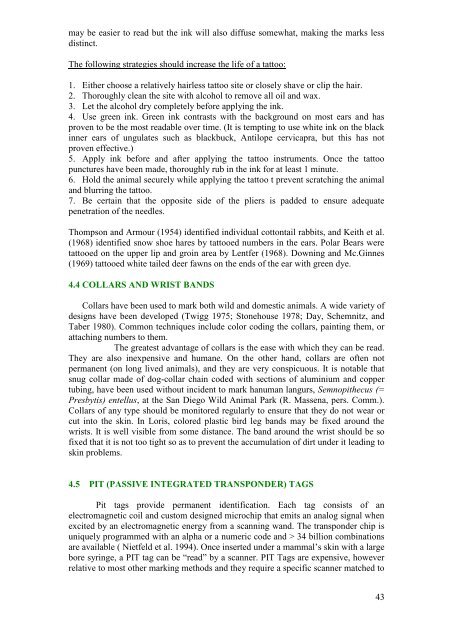standardization of records keeping in indian zoos - Central Zoo ...
standardization of records keeping in indian zoos - Central Zoo ...
standardization of records keeping in indian zoos - Central Zoo ...
Create successful ePaper yourself
Turn your PDF publications into a flip-book with our unique Google optimized e-Paper software.
may be easier to read but the <strong>in</strong>k will also diffuse somewhat, mak<strong>in</strong>g the marks less<br />
dist<strong>in</strong>ct.<br />
The follow<strong>in</strong>g strategies should <strong>in</strong>crease the life <strong>of</strong> a tattoo:<br />
1. Either choose a relatively hairless tattoo site or closely shave or clip the hair.<br />
2. Thoroughly clean the site with alcohol to remove all oil and wax.<br />
3. Let the alcohol dry completely before apply<strong>in</strong>g the <strong>in</strong>k.<br />
4. Use green <strong>in</strong>k. Green <strong>in</strong>k contrasts with the background on most ears and has<br />
proven to be the most readable over time. (It is tempt<strong>in</strong>g to use white <strong>in</strong>k on the black<br />
<strong>in</strong>ner ears <strong>of</strong> ungulates such as blackbuck, Antilope cervicapra, but this has not<br />
proven effective.)<br />
5. Apply <strong>in</strong>k before and after apply<strong>in</strong>g the tattoo <strong>in</strong>struments. Once the tattoo<br />
punctures have been made, thoroughly rub <strong>in</strong> the <strong>in</strong>k for at least 1 m<strong>in</strong>ute.<br />
6. Hold the animal securely while apply<strong>in</strong>g the tattoo t prevent scratch<strong>in</strong>g the animal<br />
and blurr<strong>in</strong>g the tattoo.<br />
7. Be certa<strong>in</strong> that the opposite side <strong>of</strong> the pliers is padded to ensure adequate<br />
penetration <strong>of</strong> the needles.<br />
Thompson and Armour (1954) identified <strong>in</strong>dividual cottontail rabbits, and Keith et al.<br />
(1968) identified snow shoe hares by tattooed numbers <strong>in</strong> the ears. Polar Bears were<br />
tattooed on the upper lip and gro<strong>in</strong> area by Lentfer (1968). Down<strong>in</strong>g and Mc.G<strong>in</strong>nes<br />
(1969) tattooed white tailed deer fawns on the ends <strong>of</strong> the ear with green dye.<br />
4.4 COLLARS AND WRIST BANDS<br />
Collars have been used to mark both wild and domestic animals. A wide variety <strong>of</strong><br />
designs have been developed (Twigg 1975; Stonehouse 1978; Day, Schemnitz, and<br />
Taber 1980). Common techniques <strong>in</strong>clude color cod<strong>in</strong>g the collars, pa<strong>in</strong>t<strong>in</strong>g them, or<br />
attach<strong>in</strong>g numbers to them.<br />
The greatest advantage <strong>of</strong> collars is the ease with which they can be read.<br />
They are also <strong>in</strong>expensive and humane. On the other hand, collars are <strong>of</strong>ten not<br />
permanent (on long lived animals), and they are very conspicuous. It is notable that<br />
snug collar made <strong>of</strong> dog-collar cha<strong>in</strong> coded with sections <strong>of</strong> alum<strong>in</strong>ium and copper<br />
tub<strong>in</strong>g, have been used without <strong>in</strong>cident to mark hanuman langurs, Semnopithecus (=<br />
Presbytis) entellus, at the San Diego Wild Animal Park (R. Massena, pers. Comm.).<br />
Collars <strong>of</strong> any type should be monitored regularly to ensure that they do not wear or<br />
cut <strong>in</strong>to the sk<strong>in</strong>. In Loris, colored plastic bird leg bands may be fixed around the<br />
wrists. It is well visible from some distance. The band around the wrist should be so<br />
fixed that it is not too tight so as to prevent the accumulation <strong>of</strong> dirt under it lead<strong>in</strong>g to<br />
sk<strong>in</strong> problems.<br />
4.5 PIT (PASSIVE INTEGRATED TRANSPONDER) TAGS<br />
Pit tags provide permanent identification. Each tag consists <strong>of</strong> an<br />
electromagnetic coil and custom designed microchip that emits an analog signal when<br />
excited by an electromagnetic energy from a scann<strong>in</strong>g wand. The transponder chip is<br />
uniquely programmed with an alpha or a numeric code and > 34 billion comb<strong>in</strong>ations<br />
are available ( Nietfeld et al. 1994). Once <strong>in</strong>serted under a mammal‟s sk<strong>in</strong> with a large<br />
bore syr<strong>in</strong>ge, a PIT tag can be “read” by a scanner. PIT Tags are expensive, however<br />
relative to most other mark<strong>in</strong>g methods and they require a specific scanner matched to<br />
43
















